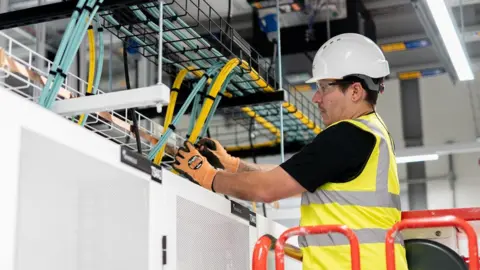 Datalec
DatalecIf someone had asked Billy Keeper five years ago what a datacentre was, he admits: “I would not have had a clue.”
The 24-year-old joined specialist electrical firm Datalec Precision Installations as a labourer straight from school.
He’s now an electrical supervisor for the UK-based firm, and oversees teams up to 40-strong carrying out electrical and cabling installations at datacentres.
This means, “managing the job, from a health and safety perspective, making sure everything goes smoothly, and dealing with the clients”.
And those clients are central to today’s technology landscape. Datacentres are the massive warehouse-like buildings from which big tech firms like Amazon, Microsoft and Facebook deliver their cloud services.
Other organisations, large and small, run their own dedicated facilities, or rely on “co-location” datacentres to host their computer equipment.
Demand for datacentre space has been turbocharged in recent years by the rise of artificial intelligence, which demands ever more high-end computers, and ever more electricity to power them.
Total datacentre floorspace across Europe was just over six million sq ft (575,418 sq m) in 2015, according to real estate firm Savills, but will hit more than 10 million sq ft this year. In London alone, datacentre “take up” in 2025 will be almost triple that of 2019, predicts real estate services firm CBRE.
But while demand is surging, says Dame Dawn Childs, chief executive of UK-based operator, Pure Data Centres Group, “delivering and satisfying that demand is challenging.”
Just finding enough land or power for new datacentres is a problem. Labour’s election manifesto promised to overhaul planning to encourage the building of infrastructure, including datacentres and the power networks they rely on.
But the industry is also struggling to find the people to build them.
“There’s just not enough skilled construction workers to go around,” says Dame Dawn.
For companies like Datalec, it’s not just a case of recruiting staff from more traditional construction sectors.
Datacentre operators – whether co-location specialists or the big tech firms – have very specific needs. “It is very, very fast. It’s very, very highly engineered,” says Datalec’s operations director (UK & Ireland), Matt Perrier-Flint.
“I’ve done commercial premises, I’ve worked in universities,” he explains. But the datacentre market is particularly regimented, he says, with everything carried out “in a calculated and structured way.”
 Pure Data Centres Group
Pure Data Centres GroupCommissioning a single piece of equipment, such as one of the chiller units that keep temperatures stable within a datacentre, will involve multiple tests and “witnessing”, Mr Perrier-Flint explains, before a final full building test, with failover scenarios.
Operators will have strict timeframes to complete a datacentre build or upgrade. At the same time, they won’t want to disrupt key business periods – ecommerce operators will typically put a freeze on any work in the runup to Christmas for example.
This can mean long days for Datalec’s teams, or even running shifts overnight.
If the demands are high, the rewards are significant too. Experienced electrical installers can make six figure salaries.
Nevertheless, companies like Datalec face a constant battle to ensure they have enough suitably qualified staff on hand.
 Datalec
DatalecThe Construction Industry Training Board predicts the UK needs to recruit 50,300 extra workers annually for the next five years. Many are concerned that the construction workforce is greying.
Dame Dawn says, “I think, along with all of the other technical industries, we’re having difficulty feeding the pipe.”
One reason for the shortfall is a focus on university education at the expense of traditional technical or apprenticeship routes in recent decades.
Mr Perrier-Flint says that when he was younger, the consensus was “you can never go wrong with a trade, you can never go wrong with construction”.
But there are more choices to tempt young people now, he suggests, including software development or other technology careers. Or indeed being an influencer on the very platforms run out of the datacentres.
Mark Yeeles, vice president, Secure Power Division, UK and Ireland, at power and automation firm Schneider Electric, began as an apprentice in the 1990s.
Given that the industry is often looking for people with 15 years’ experience, he says, “The time to start investing in apprentices was 10 years ago.”
However, Schneider Electric is changing its ratio of graduates to apprentices. “We’ve doubled our intake of apprentices,” says Mr Yeeles.
The entire industry must rethink how it recruits younger people, he adds. “My team needs to reflect the communities we’re working in,” he says, including in terms of gender, background, and experience.
And it needs to consider the career pathways it offers and recognise young people’s need for a “mission” or “purpose”. Schneider Electric, for example, has launched a sustainability apprenticeship program.
Dame Dawn agrees about the need to increase diversity and recognise recruits’ need for a mission.
“In terms of a purpose, we’re serving the whole population,” she says. “And if we could be part of the solution for net zero, then it’s serving a significant purpose, because it’s enabling humanity to drive forward.”
But perhaps the first challenge is simply explaining to potential recruits why datacentres and the cloud are central to so many facets of modern life.
As Billy Keeper says, “You try and explain to someone what the cloud is and what we offer. And they look up at the sky.”





